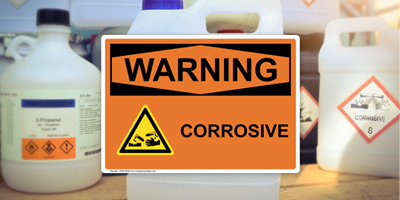Whenever corrosive chemicals and acids are in use, safety must be a top priority. You need clear, easy-to-read corrosive chemical signs to keep workers safe.
Our corrosive hazard signs and acid safety labels are a convenient way to identify chemicals that pose a danger in your workplace. All our corrosive signs are manufactured with a protective laminate that resists moisture, abrasion, UV and chemicals. Most are printed on aluminum, plastic or magnetic material, or as adhesive labels, so you can select a material and size to meet your needs.
Why Safety Signs are Required for Corrosive Chemicals
Corrosive chemicals, including acids, can destroy or damage human tissues. Their chemical actions can even destroy metal or plastic containers, so all corrosives must be identified properly. They also must be handled, stored and disposed of safely. Corrosive gases and vapors are also extremely hazardous. These materials can also pose reactivity, flammability and toxicity hazards. OSHA and the DOT each have specific rules and classifications for identifying this class of chemicals.
See a report on a fatal corrosive liquid leak - and crucial safety recommendations - in a video from the Chemical Safety Board.
The Safety Data Sheet (SDS) is the best source of information for safe use of any hazardous substance. And ComplianceSigns.com is your best source for corrosive material signs and labels.
Employers are responsible for meeting GHS/SDS requirements for all chemicals they use. Learn more about GHS compliance at SafeWork Insider.
Handling Corrosives Safely in the Workplace
The Canadian Centre for Occupational Health and Safety prepared a
fact sheet that includes tips and infrmation for working safely with corrosive materials:
- Consult the Safety Data Sheet (SDS) to learn about hazards and necessary precautions.
- Wear appropriate personal protective equipment.
- Use corrosive materials only in well-ventilated areas.
- Use the smallest amount of material necessary.
- Avoid all direct contact with the materials.
- Prevent the release of dust, mist, gas and vapor.
- Do not reuse empty containers that have held corrosives.
Protect your employees and avoid recordable workplace incidents with corrosive hazard signs from ComplianceSigns.com.
Acids and Corrosive Materials Commonly Used in the Workplace
Corrosive chemicals and acids are used to produce fertilizers, remove rust, produce plastics, manufacture chemicals, sterilize food, treat wastewater and for many other purposes. Industries that use acids include chemical and petrochemical operations, construction, pollution control, mining and metalworking. Corrosives often found in workplaces include:
- Ammonia
- Acetic acid
- Bromine
- Hydrochloric acid
- Hydrogen chloride
- Hydrogen peroxide
- Nitric acid
- Nitrogen dioxide
- Phosphoric acid
- Sulfur dioxide
- Sulfuric acid
Resources and Information on Corrosive Material Safety:
The CDC shares emergency preparedness and response information on caustic chemicals here.
OSHA Standard 1910.1200 addresses toxic and hazardous substances.
Visit the OSHA Hazcom site.
Review information on labelling chemicals in the workplace at SafeWork Insider.
Learn more about the risks of chemical burns in the workplace.



